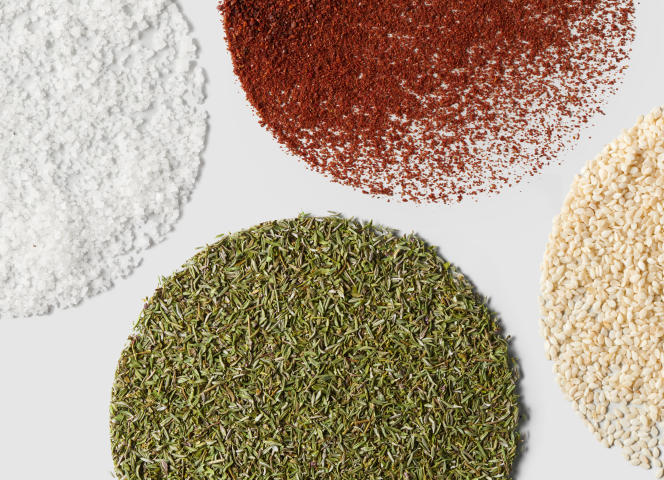It was almost 2:30 p.m. and the last customers were leaving the table in a joyous excitement. I had just finished a delicious mouhallabié – this typical Lebanese family dessert: a milky flan flavored with orange blossom, here decorated with fresh almonds – when my gaze was drawn to the large shelf that sits at the back of Tawlet , a Lebanese restaurant in the République district (Paris 11e) where I often come for lunch.
Olive oil, pomegranate molasses, tomato concentrate, bottles of arak: as my eye scanned the grocery products placed here and there, my hand ended up grabbing a small hermetic jar labeled with a strange name and filled with a dark green powder. I turned to Kamal Mouzawak to show him my find. “Zaatar?I asked him hesitantly, stumbling over the pronunciation. What is it exactly? »
The strange-sounding name reminded me of a distant kingdom; it reminded me of one of those old spells you find in old grimoires. The owner of the place, also a chef and author, originally from Beirut, raised an eyebrow, pulled a chair from under a table and gestured for me to sit down.
“The za’atarhe began by explaining to me, whistling the “z” on the tip of his tongue, it is the culinary flag of Lebanon: a taste and a smell that all Lebanese know and cherish like a Proust madeleine. Literally, in Arabic, zaatar means “thyme” – but the term is used to refer to several different things. On the one hand, the name refers to the raw product, to those hundreds of varieties of thyme, wild or cultivated, which grow in the Middle East. Traditionally, it comes in the form of dried flowers and, depending on the variety, it is eaten as is in a salad, with feta or on cottage cheese. When mixed with chopped white onion, a squeeze of lemon and olive oil, planted zaatar leaves make, for example, one of our most popular mezes. But “zaatar” is also the generic name given to this subtle blend of spices that accompanies practically all our meals. You have to make a distinction between the two. This is precisely what you hold in your hands – I will show you. »
A whole dish
Kamal unscrewed the lid of the jar and invited me to plunge my nose into it. A powerful and enveloping perfume emanated from it, evoking me pell-mell the smells of scrubland paths and simmering summer dishes.
You have 64.68% of this article left to read. The following is for subscribers only.
